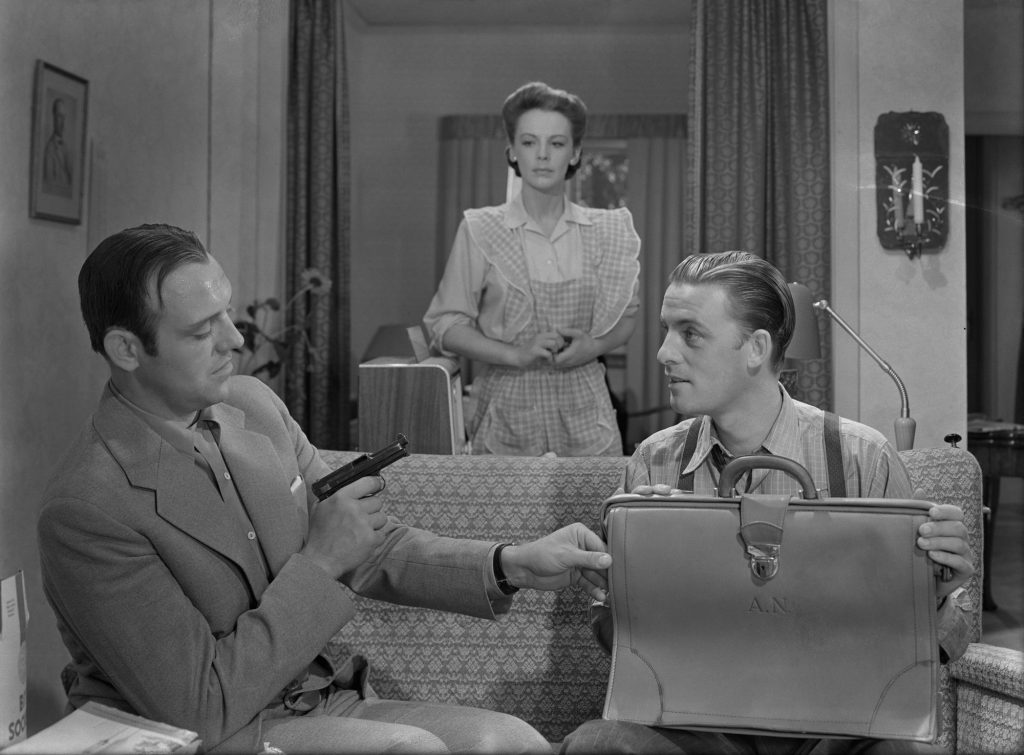Patrick Holzapfel
– “The disadvantage of film is that it remains,“ wrote Ingmar Bergman in program notes accompanying a retrospective of his own work he curated in Stockholm. Nine of his films were only shown once in a small cinema (all the other films twice). Among these nine films he included Sånt händer inte här (1950). He felt embarrassed about it.
– Jon Wengström, the curator of the Swedish Film Institute who introduced the “maybe not so good film“ talked about several reasons why Bergman felt ashamed of many of his films but prohibited only this one. One of them was that in 1959 Bergman married Estonian pianist Käbi Laretei. When the Soviet Union invaded Estonia her family fled to Sweden. As Sånt händer inte här is set among Estonian refugees but uses their story merely as a background for plot twists in a spy thriller and allegorical statements, Bergman might have felt that his work betrays his quest for truth and the life of Estonian refugees.

– More background information on how and why the film became a bad (remaining) memory for its director can be found here and here.
– The film was granted limited screening rights for the director’s centenary. It was shown around the world in 2018. I wonder if the workers of the Swedish Film Institute who brought that film as a gift to “Forever Film“, after such a year of “Bergman everywhere“, have seen enough of him or if the constant presenting and remembering brought some new perspectives on Bergman. As far as my observations from various films re-watched and texts read are concerned, Bergman stands the test of time very well but like a solid rock there is also not much new to discover.
– Earlier this year a cinephile from Sweden wrote to me about Bergman being a champion of avant-garde film. It would have been nice to use the opportunity of his centenary to also highlight that. Which films did he have in his collection? What influenced his work? What was created in Sweden opposing the cinema of Bergman? Well, there is 50 years of time until the next Bergman year.
– The Touch, a film Bergman almost equally hated, is much richer in comparison. Yet, Sånt händer inte här has its moments. Most of them are related to the cinematography of Gunnar Fischer.
– In one of the best scenes of the film, a comedic stand-off, the evil Atkä Natas (his name is kind of giving it away, isn’t it?) more or less returns from the dead and confronts his wife Vera, an émigré dissident together with her affair, the police officer Björn. There is only one gun in the room and like the mood in the film it switches from one person to the next in rather clumsy, yet (in this case) highly entertaining and funny fashion.
– It is fascinating to see how a director who is able to hold one note for a whole film, revealing nuances of human behaviour and psychology in each second, struggles so much with keeping a film together. Serious scenes take turns with almost slapstick scenes take turns with what is supposed to be a spy thriller among refugees in Stockholm. One can not get rid of the impression that the project was abandoned while it was made.
– Yet, sometimes it feels like these turns and concurrencies are more deliberate than that. For example, there is a scene in which communist agents from the state of Liquidatzia (the name is kind of giving it away, isn’t it?) torture their undercover agent who might plan to escape. Bergman focusses not only on the violent atmosphere in the room but also intercuts with an elderly couple living one floor below. They are complaining about the noise and finally decide to call the caretaker. After a while the caretaker appears at the door of the agents. They just dismiss him and that’s it. In another scene a drunken doctor utters his suspicion about a dead body being poisoned. He is not the doctor we expect to see in a spy thriller. There is something more real and warm about him. Through these scenes Bergman establishes a rather strong paradox between the plot and the places it takes place at. It is also mirrored in the title of the film (“This Can’t Happen Here” as opposed to “High Tension” or the German “Menschenjagd”)
– We also must be careful. There are other films (not only by Bergman) that are far worse but considered as masterpieces. Film history sometimes becomes a place in which an opinion is formed before seeing a film and then everything we see related to what we think we know already.
More on Forever Film
Notes on Grauzone (1979, Fredi M. Murer)
Notes on Film and Reality (1942, Alberto Cavalcanti and Ernest Lindgren)
Notes on Yadanabon (1953, Tin Maung)
Notes on White Shadows in the South Seas (1928, W.S. Van Dyke, Robert J. Flaherty)
Notes on 30 Years of Motion Pictures (1927, Otto Nelson, Terry Ramsaye)